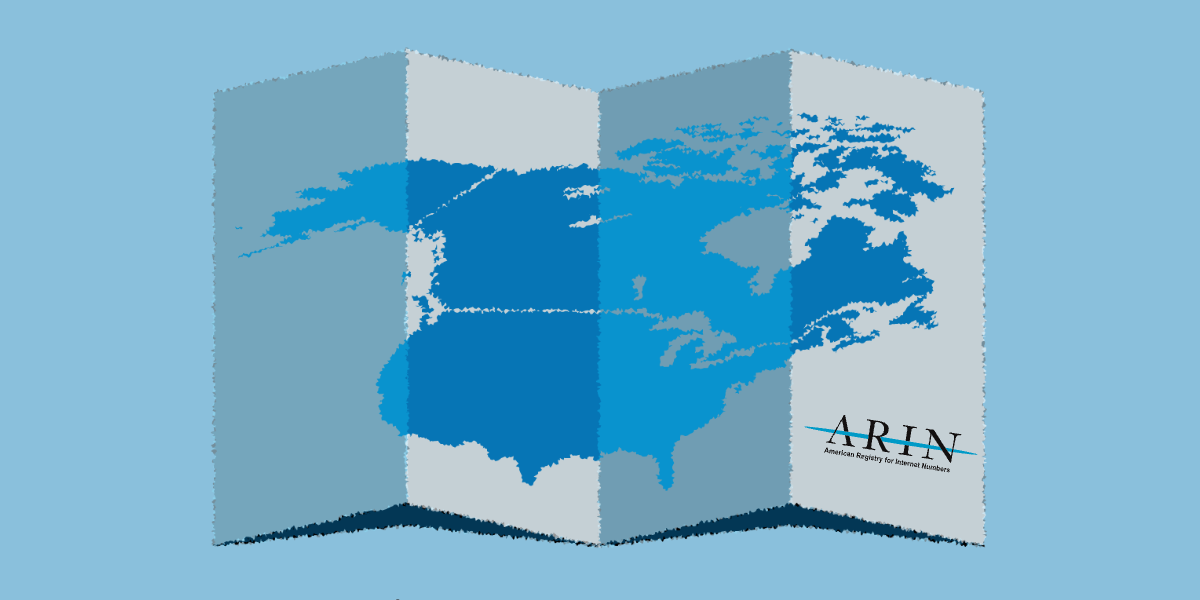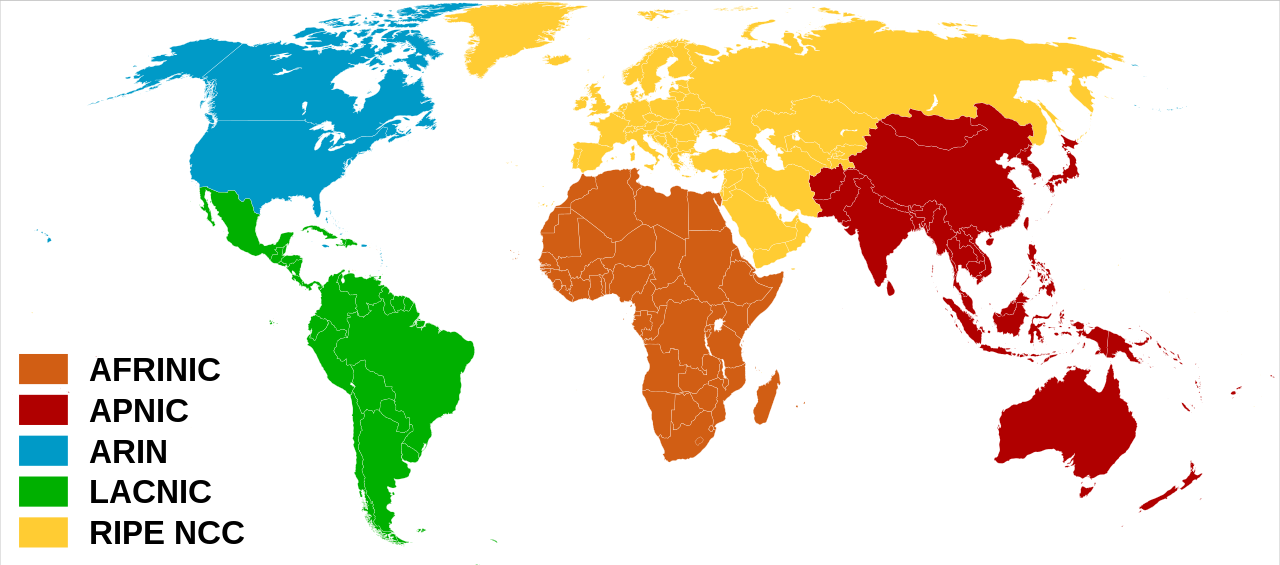What is ARIN?
The History of Internet Administration
by Leo Vegoda

The internet grew slowly, at first. The original four ARPANET nodes were connected in 1969. Computer networking grew through the 1970s and there was demand for commercial connections by 1988. The Washington Post reported that there were 500,000 internet users that year[PT1]. Users who enjoyed access while at university or work, wanted to retain access for the social connection it provided.
Although registry data was collected as early as 1971, the first recorded use of the term Internet Assigned Numbers Authority (IANA) was also in 1988.
While the name IANA references numbers, it manages three sets of data (and their [PT2] functions) for the internet. These are:
- Names – the Root DNS zone and associated technical registries
- Numbers – the IP addresses and AS Numbers used by networks
- Protocol Parameters – over 3,000 registries of technical settings, like the descriptions for the types of files attached to mail messages
But any reasonably complex system requires management. Organizations also need rules by which to operate consistently and efficiently. Which is to say, the administration of the internet needed a kind of civil service. The internet’s civil service had been established in one man: Jon Postel. But because the internet was so small, he both set and administered policy.
History suggests that a system involving large numbers of people ought to separate the policy making for that community and the administration of those policies. Doing so avoids conflicts of interest and worse. So the growing internet needed separate policy making. Quite naturally, the pressure for resource management policies grew with the reach of the internet.
The Global Internet
The increasing globalization of the internet led to guidelines for new registries outside the US. RIPE NCC, serving an area centered on Europe, was established in 1992 and APNIC, serving the Asia Pacific, followed a few months later. InterNIC managed both domain name and IP address registration in North America from 1993 until 1998, when ARIN was the third Regional Internet Registry (RIR) to be established.
LACNIC, serving Latin America and parts of the Caribbean, was established in 1999 and recognized by ICANN in 2002. Three years later, AFRINIC was recognized and became the fifth RIR, serving Africa and the Indian Ocean.

Fig 1: By 2005 there was a professional and impartial RIR serving each continent
ICANN, the Internet Corporation for Internet Names and Numbers, was established in 1998. It was created to reduce the US government’s direct responsibility for the internet. ICANN took on the IANA functions and created a policy for recognizing new RIRs.
By way of broad description, ICANN offers the following overview and graphic element on the internet:
“The Internet itself is a globally distributed computer network comprised of many voluntarily interconnected autonomous networks. Similarly, its governance is conducted by a decentralized and international multistakeholder network of interconnected autonomous groups drawing from civil society, the private sector, governments, the academic and research communities, and national and international organizations. They work cooperatively from their respective roles to create shared policies and standards that maintain the Internet’s global interoperability for the public good.”

Fig 2: Registries are run by formal organizations but standards and policy development is
ICANN, IANA, InterNIC, and the RIRs all maintained public registries identifying which organizations used internet resources. They also provided standardized, non-discriminatory, processes for requesting new resources and updating registration information.
The regionalization of registration provided several benefits. Firstly, international bandwidth was still expensive, so distributing the service lowered costs. Having a registry in roughly the same time zone as users allowed for telephone conversations. And each registry created a regional forum for the exchange of expertise and development of policy.
ARIN’s policies for North America could reflect its specific needs.
RIR Functions
The RIRs all provide the same core services.
- They run a registry containing the public information for each AS Number or block of IP addresses, and the private information, like the contact and payment details for the members they provide services to.
- They provide registration services to new and existing organizations. These originally focused on allocating new blocks. Since exhaustion, they focus on properly registrering transfers.
- They provide public forums for developing the policies that govern the distribution and registration of IP addresses and AS Numbers.
Some of the RIRs also provide technical training and forums to discuss internet management issues, like IPv6 adoption.
RIR Policy History
When John Postel was the IANA he used his good sense when allocating blocks of IP addresses. Policy development had to be formalized as the internet grew in importance and administration was distributed around the world.

Fig 3: Jon Postel – Photo by Irene Fertik, USC News Service. © 1994, USC.
These policies had to be anchored in the capabilities of the networking technology. At first, this meant distributing addresses in three block sizes because that is what the routing protocol demanded. We’ve written more about the development of routing technology here.
CIDR, which allowed more granularity, was introduced in 1993 as the RIRs were being formed. The RIRs soon created policies that reflected the adoption of CIDR. (Read more about CIDR in the blogs CIDR in Networking and Making CIDR.)
In 1996, RFC 2050 documented the four goals that have guided policy ever since:
- Uniqueness – Each public Internet address worldwide must be unique.
- Aggregation – Address distribution should follow network topology.
- Conservation – Fair distribution addresses based on operational needs.
- Registration – Public documentation of address space to support uniqueness and operational coordination.
ARIN now supplements these with two goals. One addition is stewardship. This is to ensure that addresses go to those who will use them. The other is reserved pool replenishment. This is to ensure that addresses can be allocated when returned to ARIN.
The policy details varied between the RIRs but the direction of travel was to make the policy less generous as IPv4 became more scarce.
ARIN has adapted to IPv4 Exhaustion
IPv4 exhaustion was first predicted at the San Diego Internet Engineering Task Force meeting in 1992. Improved technology and policy have continued to push the date further into the future.
IANA allocated 19 /8 blocks – each about 16 million addresses – in 2010: about 8 percent of the available total. There are about 8 billion people in the world and only 3.7 billion IPv4 addresses available for use.
The internet’s ability to deliver valuable personalized communications, information, and entertainment at low cost was unprecedented. It was a huge market success. The size of the IPv4 space was seen as very generous when IPv4 was developed. Most network protocols of the time allowed for 256 or 65,000 connections. The inventors could not have anticipated that everyone in the world would want to connect.
IANA allocated its last five /8s blocks in 2011.
IANA started allocating the RIRs smaller blocks in 2014. Each RIR got just 256 addresses in [1] [2] 2019 – the last crumbs.
ARIN and the other RIRs implemented waiting lists, so that new organizations could get some IPv4 addresses for the cost of a membership.
The waiting list is currently long but serves a purpose. Sometimes an organization closes without transferring its addresses away. ARIN reclaims those addresses and can then allocate them to a new organization through the waiting list.
They also manage transfer processes. One recognizes transfers that result from corporate mergers and acquisitions. The other lets organizations transfer addresses to a specified recipient.
ARIN vets and approves Qualified Facilitators. These are organizations that help organizations that need addresses from the market. Facilitators must now pass a certification program. The goal is to ensure that facilitators can get a transfer completed. ARIN wants them to provide robust assistance to organizations transferring space away or in[3] [4] [5] .
The key requirements are:
- Follow the Facilitators’ Code of Conduct
- Third-party background checks for all key employees
- Certify their compliance with the facilitator qualifications every year
- Be legally registered in the ARIN service region
- Maintain necessary insurance
- Indemnify ARIN
Impact of IPv6 and Future Considerations
The journey from 1969 to 2023 connected more than half the world’s people. We still need to connect the other half. Multiple agencies and businesses are also developing plans for permanent, automated and humanly-occupied bases on the moon, which is close enough for real time communication. IPv4 has been spread very thin but is unlikely to stretch far enough to connect everyone and everything that people want from the future internet.
IPv6 is the more spacious solution to IP addressing.
ARIN began allocating IPv6 addresses in 1999. It was a global bootstrap process to learn from the first 100 allocations. This experience could be used to develop the policy needed by organizations deploying IPv6 in their networks.
ARIN’s community joined the APNIC and RIPE communities to use that experience to develop a coordinated policy. It was ready in 2002. The key differences from IPv4 policy are the overwhelming importance of the aggregation goal and a new goal: minimizing overhead.
The core of IPv6 policy developed in 2002 has worked well. Google reports that almost half of its traffic now comes over IPv6. Despite this, barely 0.5% has been allocated for use because there is so much IPv6 address space.
Each new ARIN member’s default allocation is enough to serve at least 6 million residential subscriber customers. And they can get more if they need them.
The major challenge of internet use worldwide isn’t the availability of address space. It’s making sure that the low density and island nation communities have good internet service.
The Future of Internet Resource Management
The internet’s civil service has proved itself a reliable steward of the internet’s number resources over the last 35 years.
ARIN and the other RIRs have reliable processes for requesting and managing both IPv4 and IPv6 addresses. They support community-led policy development while ensuring their people do not advocate for policy outcomes.
They operate reliable infrastructure. The public has access to registry data and members can manage that data through web portals and APIs.
ARIN and the other RIRs are consistently improving their support for RPKI, the digital certificate technology used to improve the security of internet routing.
When Jon Postel proposed recording “Sockets in use” in 1971, this kind of registry function was innovative for computer networking. ICANN, IANA, ARIN and the other RIRs have made the management of internet number resources a mundane piece of infrastructure. Their services are highly reliable and are used by most consumer and business internet services.
They have smoothly managed the transition from a free pool of IPv4 addresses to a market based transfer system. IPv4 addresses remain available to organizations that need them.
If your organization falls into this category, IPv4 Global is a trusted partner you can rely on. We’re a fast and transparent broker of IPv4 addresses.
Contact us today to learn more.